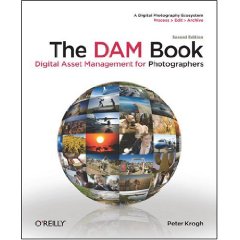A brand new DAM
 It was no secret that it was on the way, but my friend Peter Krogh’s The DAM Book has now been listed on Amazon US and Amazon UK. The original book was immediately unusual in its cover not being emblazoned with “Photoshop CS2” or focussing on the image processing side of the pixel mountain. Peter rightly saw that the management and safeguarding of digital photos was digital photography’s dangerously-neglected aspect, and this understanding of the real needs meant the book’s shelf life extended across software release cycles and remained applicable after entirely new programs were introduced. But even long-lasting underlying principles eventually need dusting off, and this new version of the book is a complete rewrite. Thanks Peter for asking me to tech edit a couple of chapters – I look forward to my signed copy!
It was no secret that it was on the way, but my friend Peter Krogh’s The DAM Book has now been listed on Amazon US and Amazon UK. The original book was immediately unusual in its cover not being emblazoned with “Photoshop CS2” or focussing on the image processing side of the pixel mountain. Peter rightly saw that the management and safeguarding of digital photos was digital photography’s dangerously-neglected aspect, and this understanding of the real needs meant the book’s shelf life extended across software release cycles and remained applicable after entirely new programs were introduced. But even long-lasting underlying principles eventually need dusting off, and this new version of the book is a complete rewrite. Thanks Peter for asking me to tech edit a couple of chapters – I look forward to my signed copy!
And now for some of my own reflections… (or alternatively). When you look back at the the original book, it offered a solution containing four main strands – Bridge, iView, Photoshop, and DNG tying it all together and letting you see the adjusted raw data in any other program. I had already adopted the same sort of workflow before the original book came out, and my first contact with Peter was when he noticed something I’d posted about DNG in a forum. In fact, around the time he must have begun his book for O’Reilly, my UK publishers had turned down my similar book proposal as they thought their US partners – O’Reilly – simply wouldn’t be interested in the topic….
So I was already very much in agreement with his approach then, and it’s interesting to consider how things have changed over 4-5 years. For the better? Well, I’m not so sure. In Lightroom and Aperture we do have a pair of new and significant cataloguing programs which combine processing with DAM, but extensible XMP’s promise of portable metadata remains unfulfilled by them (Aperture can’t even read sidecar files) and the idea of a DAM program limited to camera-originated file types is now challenged – if it was ever valid – by our having three DSLRs that can output video too.
Have things changed for the worse then? No, not that either – the old four-legged solution still works fine, Bridge CS4 is a big leap forward (for example), Adobe have maintained parity and let you do the same adjustments either in Lightroom or the Camera Raw dialog (perhaps surprisingly when they could have introduced more product differentiation here), while iView’s still there in its Microsoft Expression Media guise and still shows your DNGs’ adjusted appearance. Bigger raw files keep piling up, Nikon and Canon still fail to offer DNG as an option, still offer in-camera settings that only make sense if you use their own raw converters and which you never have time to set when you’re busy snapping, and otherwise-excellent programs like Capture One still insist on new file formats (at least for now only their medium format back customers are being offered this delightful suppository).
But we will continue to cope – all this still hasn’t overwhelmed the fingers in the dyke of yet-bigger hard drives, multi processor cores, and all that the extra RAM – and we’re still successfully finding yet more comforting ways to slow computers down to our thinking speed. Maybe “different” is all we can ever expect, and success in DAM is still being there, still holding back the flood (the version on Fripp’s Exposure LP is even better).